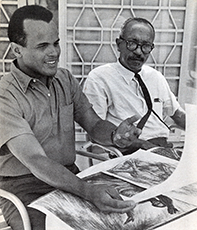
On April 2, we celebrate the 100th anniversary of the birth of African American painter and graphic designer Charles White. According to Roosevelt University professor Erik Gellman in The Black Chicago Renaissance, White not only “applied his art as a weapon in Chicago,” but he discovered a unique appreciation and love for African American history not at school, but at Chicago Public Library.
White took an early interest in art. His mother bought him an art kit when he was around 7 years old. While attending Englewood High School, he helped design sets for school plays. When he was 14, the George Cleveland Hall Branch opened and White found himself spending a good number of hours poring over the book collection curated by head librarian Vivian G. Harsh. He was most impressed by Alain Locke’s The New Negro.
During the Depression, artist George Neal assembled some of his students into an Arts Crafts Guild that collaborated on work, held parties to help members attend the School of the Art Institute of Chicago and exhibited everywhere from the Wabash Y to vacant lots. White took a few of his drawings to a guild meeting and became a member. Other members included Margaret Burroughs and Eldzier Cortor.

In 1937, White won a scholarship to the School of the Art Institute, despite not graduating from high school. Like plenty of other “starving artists,” White took a position with the WPA’s Federal Art Project, where he worked to produce one public art painting every five weeks. It was during his tenure that the WPA asked White to create a mural for the Hall Branch. According to a 1965 interview, White insists that the subject for his oil on canvas mural was “five outstanding Negroes.” Four of the subjects chosen were George Washington Carver, Booker T. Washington, Sojourner Truth and Marian Anderson. Images of, or even newspaper reports of, the mural’s unveiling or display have yet to be uncovered. It seems people remember the mural, but sadly there are no long-lasting mementos.
By the time of the 1940 American Negro Exposition, White’s There Were No Crops This Year won a first prize award and graced the cover of the catalog for the exposition’s Henry O. Tanner Gallery. At the same time, the Associated Negro Press commissioned his History of the Negro Press mural for their exhibit at the exposition.
White eventually left Chicago in 1941 and taught at Dillard University, where he met sculptor Elizabeth Catlett. The two were briefly married. In 1965, White left New Orleans for Los Angeles, where he stayed until his death in 1979.
This summer the Art Institute of Chicago is hosting a Charles White retrospective. We hope to see you there! To learn more about Charles White, please enjoy the interviews with his contemporaries at The HistoryMakers or check out these resources:



Add a comment to: Celebrating Chicagoan, African American Painter Charles White